Transform your home into a calming sanctuary with 25 Japandi interior ideas that blend minimalist elegance with natural elements. Embrace neutral color palettes and earthy tones to create a serene backdrop. Incorporate warm woods and natural materials for texture, while choosing minimalist furniture that prioritizes function. Add indoor plants for life and softness, and round out the design with rugs to enhance warmth. Discover how simple choices foster zen-like balance throughout your space. There’s so much more ahead to explore!
1. Embrace Neutral Color Palettes

When you embrace neutral color palettes in your Japandi-inspired space, you’re not just choosing colors; you’re creating a serene atmosphere that fosters relaxation and mindfulness. Soft whites, muted grays, and earthy beiges form a calming backdrop, allowing other elements to shine without overwhelming the senses. The beauty of these hues lies in their versatility; they blend seamlessly with both modern and traditional furnishings.
By incorporating varying shades within your palette, you can add depth and dimension, creating visual interest while maintaining a tranquil vibe. This approach encourages a sense of harmony, making your space feel cohesive and inviting.
Consider using textured fabrics and minimalist decor to enhance the overall aesthetic. This not only adds warmth but also emphasizes the simplicity that defines Japandi style. Ultimately, a neutral palette invites you to unwind, providing the perfect sanctuary for reflection and rejuvenation.
2. Incorporate Natural Materials
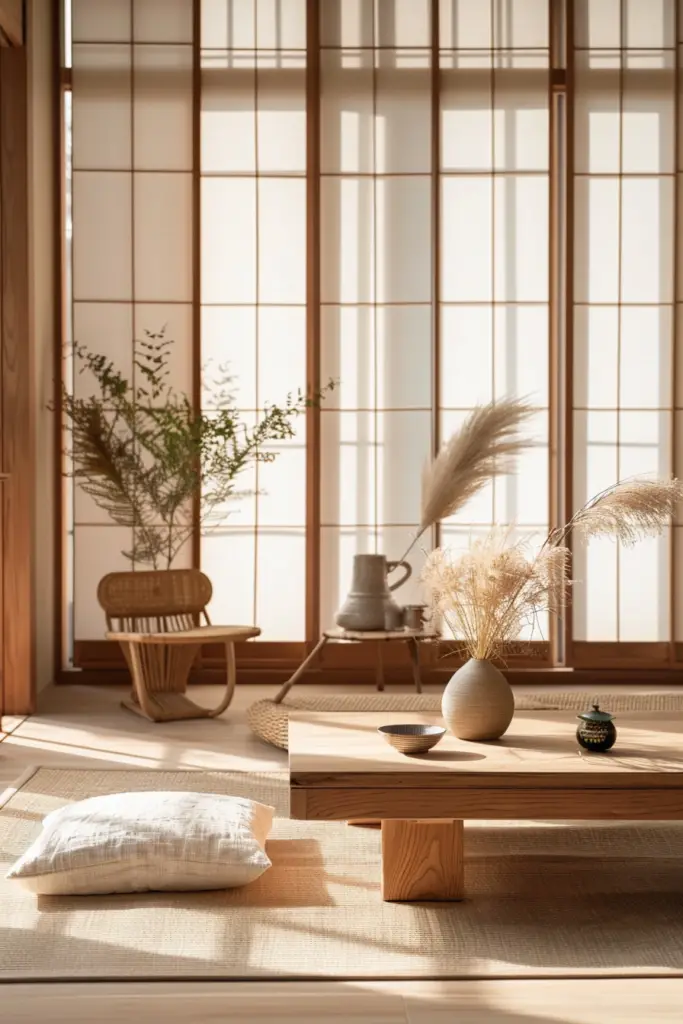
Incorporating natural materials into your Japandi interior brings an organic touch that enhances the overall aesthetic. Think about using wood, stone, bamboo, and jute to create a harmonious balance between nature and design. Choose warm-toned woods for furniture or flooring, as they add warmth and texture, grounding your space.
Stone accents, like a slate coffee table or a pebble vase, introduce a sense of solidity and connection to the earth. Bamboo, with its sleek lines, can be used in window treatments or decorative elements, bringing an airy feel.
Don’t forget textiles! Soft, natural fabrics such as linen and cotton add comfort while maintaining a simple elegance. Look for rugs made from jute or sisal to anchor your rooms. By thoughtfully integrating these materials, you’ll create a serene environment that embodies the Japandi philosophy of minimalism and nature’s beauty.
3. Choose Minimalist Furniture

Minimalist furniture is the backbone of any Japandi interior, creating a clean and uncluttered space that promotes tranquility. When choosing your pieces, think simplicity and functionality. Opt for furniture with sleek lines and neutral colors that blend seamlessly into the background, allowing natural materials and textures to shine. Look for items made from wood, bamboo, or rattan, emphasizing craftsmanship and organic shapes.
Consider multi-functional furniture, such as a low-profile coffee table that doubles as storage, to maximize space while keeping things tidy. Avoid ornate details and heavy embellishments; instead, embrace pieces that speak to the beauty of simplicity.
Incorporate a few statement pieces that resonate with you, but remember less is often more. This minimalist approach not only enhances the aesthetic but also fosters a sense of calm, inviting you to relax and recharge in your serene sanctuary.
4. Use Low-Profile Seating

Low-profile seating is essential for achieving the Japandi aesthetic, offering a sense of groundedness that complements the overall design. These low-slung chairs and sofas invite a feeling of tranquility, encouraging relaxation and mindfulness. Think about incorporating pieces crafted from natural materials like wood or woven fibers, which harmonize beautifully with the minimalist approach.
When choosing your seating, look for clean lines and subtle colors that blend seamlessly with your space. This not only maintains the serene atmosphere but also maximizes the visual flow of your room. You might consider adding cushions or throws in muted tones to enhance comfort while keeping the look refined.
5. Add Indoor Plants
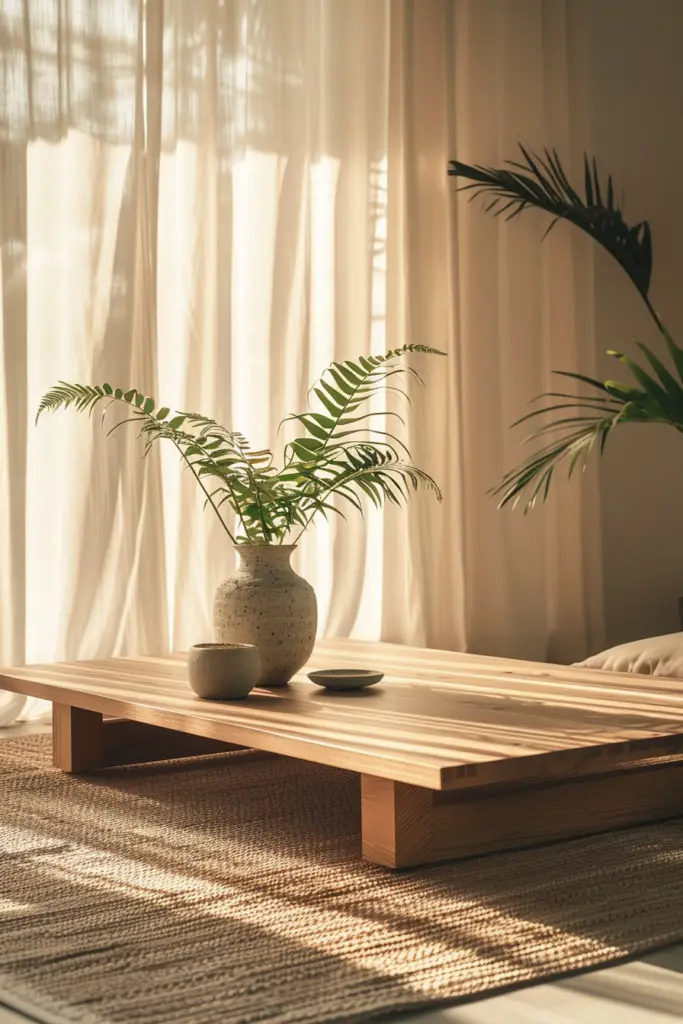
While you’re curating your Japandi space, adding indoor plants can elevate the serene vibe and bring a touch of nature indoors. Think about incorporating plants like snake plants or pothos, which not only purify the air but also thrive in low light. Their lush green leaves create a beautiful contrast against the minimalist decor typical of Japandi style.
Consider using simple, ceramic pots or wooden planters that blend seamlessly with your aesthetic. Place them on low tables or windowsills to draw the eye and create a sense of harmony.
Grouping plants of varying heights can add depth and interest, while staying true to the Japandi principle of balance. You might also want to choose plants with sculptural forms, like a ZZ plant, for a striking focal point. Ultimately, these natural elements will enhance your space, making it feel more inviting and tranquil.
6. Opt for Sliding Doors
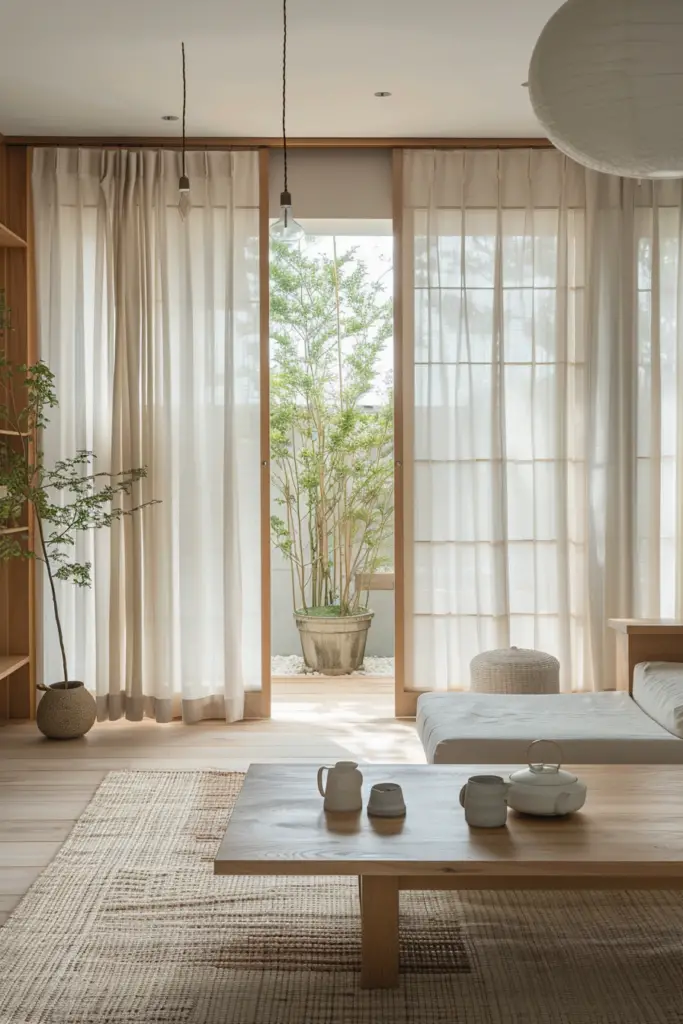
Sliding doors can be a stunning addition to your Japandi interior, blending functionality with elegance. These doors seamlessly connect spaces while offering versatility in layout and design. You can choose from a variety of materials like wood or frosted glass, allowing you to match the natural aesthetics of Japandi style.
When closed, sliding doors provide privacy and reduce noise, creating a tranquil environment ideal for relaxation. When opened, they invite light and fluidity, enhancing your space’s overall ambiance.
Consider using sliding doors as room dividers to create intimate areas without sacrificing openness. Their minimalist design resonates with the Japandi philosophy, emphasizing clean lines and simplicity.
7. Create Open Spaces
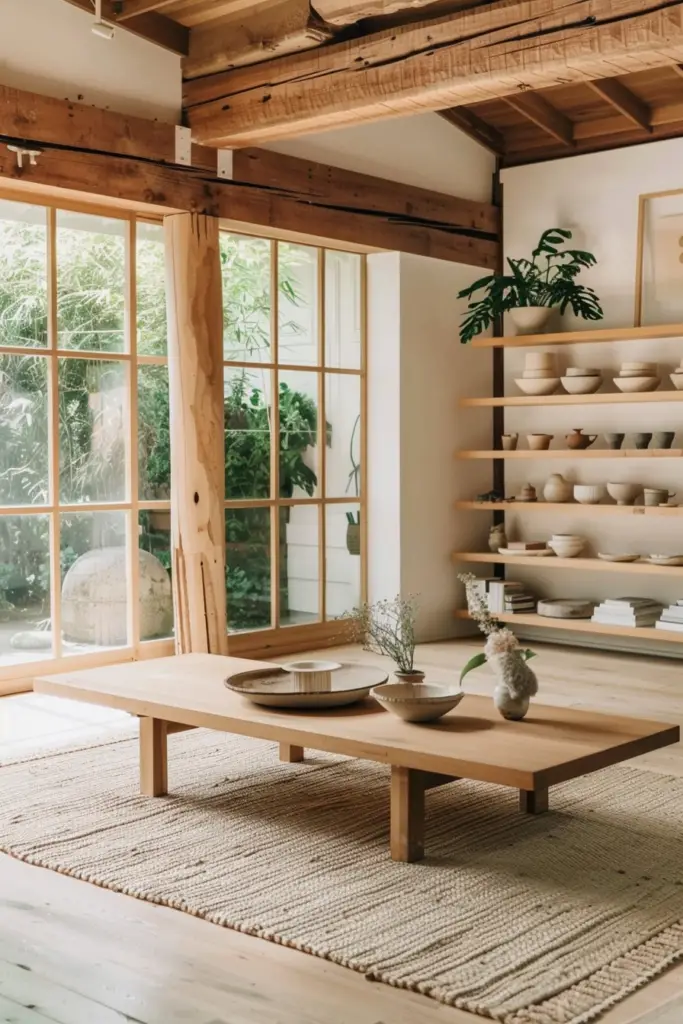
To achieve the serene atmosphere characteristic of Japandi style, you should focus on creating open spaces that promote a sense of calm and connection. Begin by removing unnecessary furniture and clutter; a minimalist approach allows your space to breathe. Think about how you can utilize natural light—large windows or glass doors can make your area feel more expansive and inviting.
Consider using low-profile furniture that doesn’t overpower the room, allowing for easy movement and flow. Incorporate soft textures and neutral tones to enhance the peaceful vibe while keeping the aesthetic cohesive.
Strategically placed plants can also add life to your open spaces, bringing in a touch of nature that aligns with the Japandi philosophy. Remember, the goal is to create a harmonious environment where each element has its purpose, contributing to an overall sense of tranquility and balance.
8. Implement Multi-Functional Spaces

As you embrace the Japandi aesthetic, implementing multi-functional spaces becomes essential for maximizing both utility and serenity. Think of your living area as a canvas where every piece serves a purpose. Incorporate furniture that can adapt to your needs; a sleek coffee table can transform into a workspace with ease. Consider a daybed that doubles as a cozy reading nook and a guest bed.
Use natural materials and minimalist designs to maintain a clutter-free environment, allowing you to feel grounded. Zones can be defined through subtle changes in color or texture, creating a seamless flow while keeping everything functional. A small dining table can also serve as a home office, promoting productivity without sacrificing comfort. By blending practicality with aesthetic appeal, you’ll cultivate a harmonious space that encourages relaxation and creativity, perfectly embodying the Japandi spirit.
9. Focus on Textural Contrast
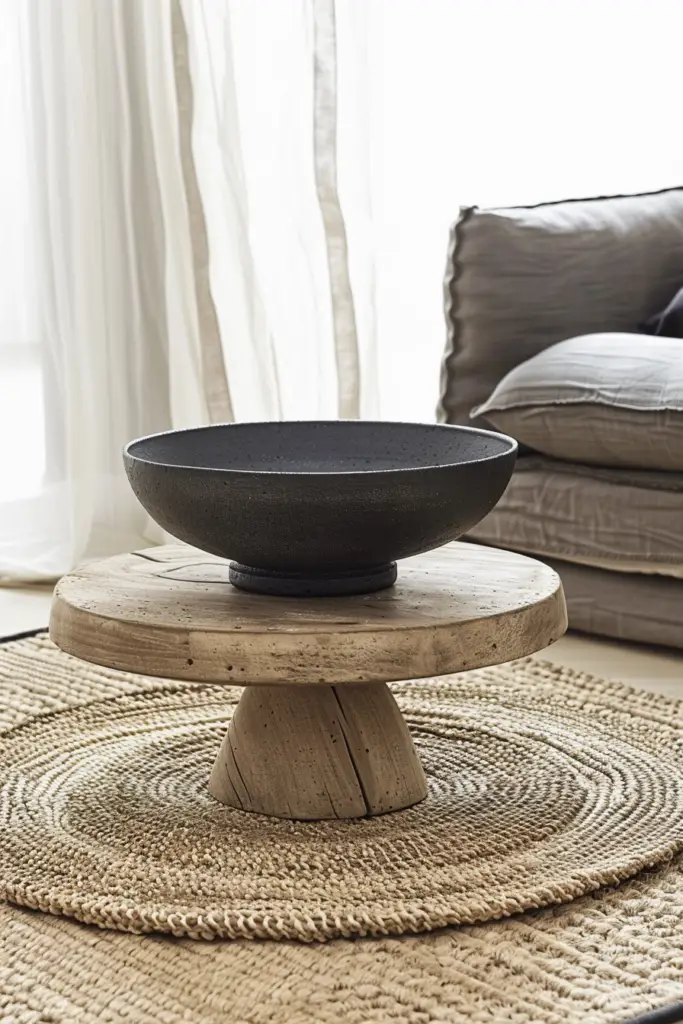
While embracing the Japandi style, focusing on textural contrast can elevate your space and create visual intrigue. Think about combining smooth, sleek surfaces with rustic, organic elements. You might pair a polished wooden table with soft linen tableware or a sleek bamboo chair alongside a chunky wool throw. This interplay not only enhances the aesthetic but also invites a tactile experience.
In your decor, consider layering different materials—ceramics, metals, and natural fibers. A ceramic vase can sit atop a coarse jute runner, creating a pleasing contrast that draws the eye. Don’t shy away from mixing glossy finishes with matte textures, as this contrast can add depth and interest.
Ultimately, it’s about balance. By thoughtfully integrating various textures, you’ll evoke a sense of harmony that embodies the essence of Japandi design. This approach guarantees your space feels both inviting and serene, inviting you to relax and unwind.
10. Highlight Natural Light
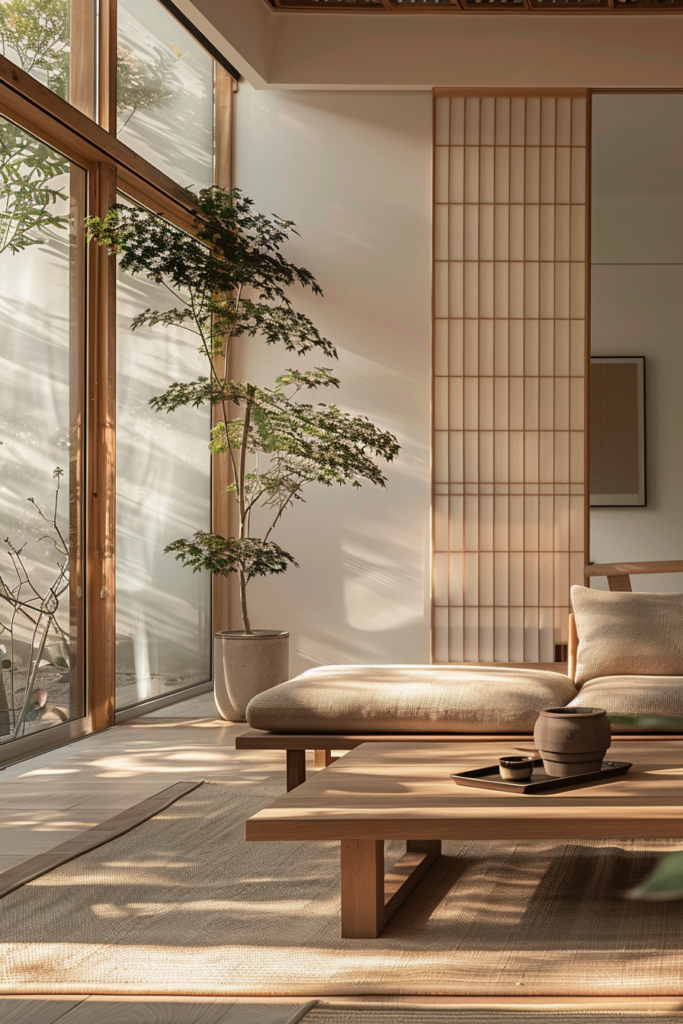
Natural light plays an essential role in Japandi interiors, enhancing the serene and minimalist aesthetic that defines this style. To maximize natural light, consider the layout of your space. Position furniture away from windows, allowing sunlight to pour in and illuminate the room. Use sheer curtains or blinds that can be easily opened to invite brightness without sacrificing privacy.
Opt for light, neutral colors on walls and furnishings to reflect light and create an airy feel. Incorporating mirrors can also amplify natural light, making your space feel larger and more inviting.
Additionally, you might want to select strategically placed indoor plants that thrive in natural light, adding a touch of nature while promoting tranquility. By embracing natural light, you’ll create a harmonious environment that embodies the Japandi philosophy, blending functionality with beauty and fostering a sense of calm in your home.
11. Select Handcrafted Accessories
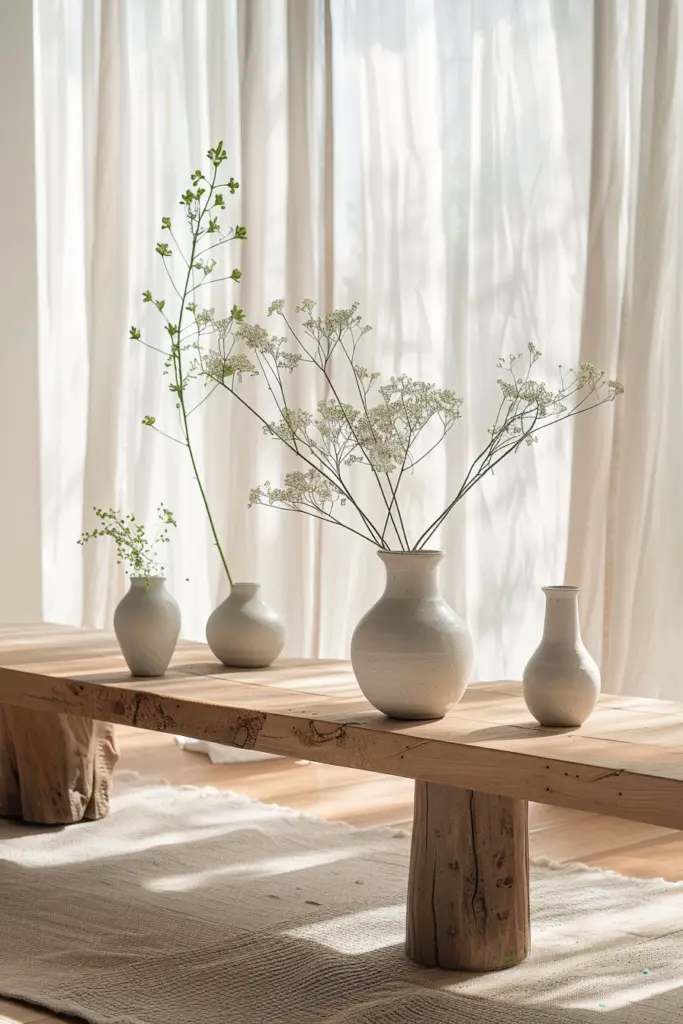
Incorporating handcrafted accessories can truly elevate your Japandi interior, infusing it with character and a sense of authenticity. Look for items that reflect Japanese minimalism and Scandinavian functionality, like handmade pottery or woven textiles. These pieces not only serve a purpose but also tell a story, showcasing the skill and artistry behind them.
Consider adding unique vases, deliberately crafted from natural materials, to display simple floral arrangements or even branches. A hand-carved wooden bowl can serve as both decor and a functional item for everyday use.
Don’t overlook textiles—soft, organic cotton or linen cushions can add warmth without overwhelming the space. When you choose accessories, think about their shapes and textures; smooth, rounded forms paired with rustic finishes create a harmonious balance. By selecting these handcrafted elements, you’ll create a serene environment that feels both inviting and thoughtfully curated.
12. Integrate Japanese Tatami Mats
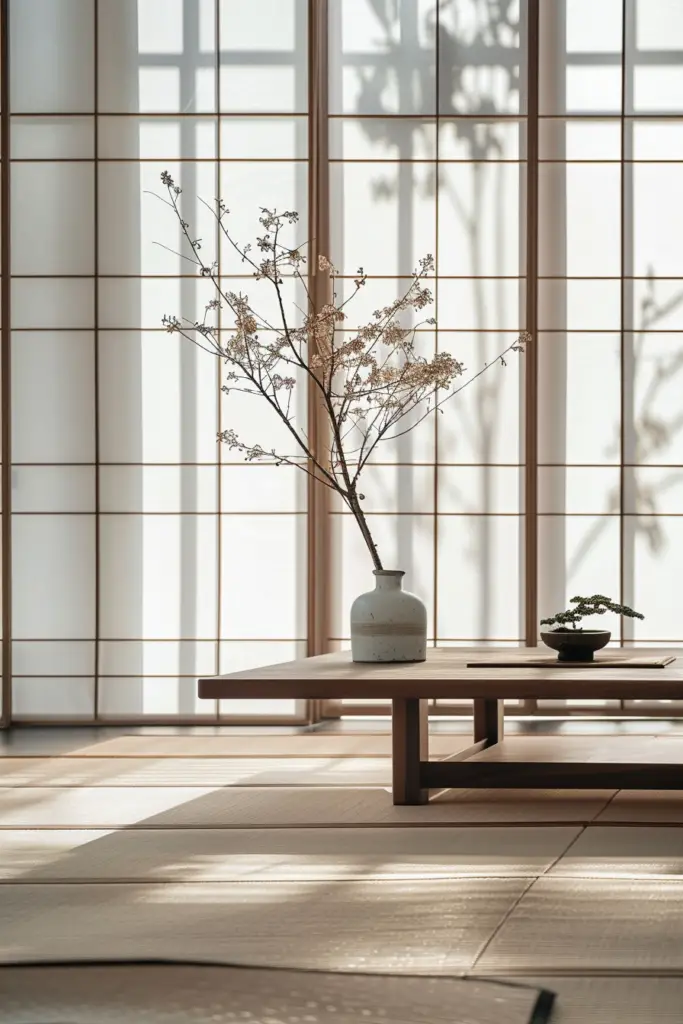
Japanese tatami mats are a beautiful way to add authenticity and warmth to your Japandi interior. These traditional mats, made from rice straw and covered with woven rush grass, bring a unique texture that instantly elevates the ambiance of a room. When you integrate tatami mats, you’re not just adding flooring; you’re introducing a sense of calm and a connection to nature.
Place them in your living spaces or bedrooms for a cozy, inviting feel. You might consider arranging low furniture, like a coffee table or cushions, to complement the mat’s height, creating a harmonious environment. Additionally, the earthy tones of tatami mats can balance the minimalist Scandinavian elements, fostering a serene atmosphere.
To maintain their longevity, remember to keep them dry and well-ventilated. With thoughtful placement and care, these mats can transform your space into a zen-like retreat you’ll love coming home to.
13. Use Scandinavian Textiles

While you’re creating a Japandi interior, using Scandinavian textiles can add warmth and comfort to your space. These textiles, known for their minimalistic yet cozy designs, can seamlessly blend with the clean lines of Japanese aesthetics. Opt for soft wool blankets, airy linen curtains, or plush area rugs that invite relaxation and enhance the overall ambiance.
Consider incorporating muted colors or subtle patterns that echo nature, reflecting the serene beauty of both Scandinavian and Japanese design philosophies. A chunky knit throw or a lightweight cotton pillow can provide both comfort and visual interest, making your space feel inviting.
Using textiles with natural fibers not only elevates the tactile experience but also promotes sustainability, a core principle in both styles. By thoughtfully selecting these elements, you’ll create a harmonious balance that encourages tranquility and mindfulness, essential components of a true Japandi interior.
14. Incorporate Wood Elements
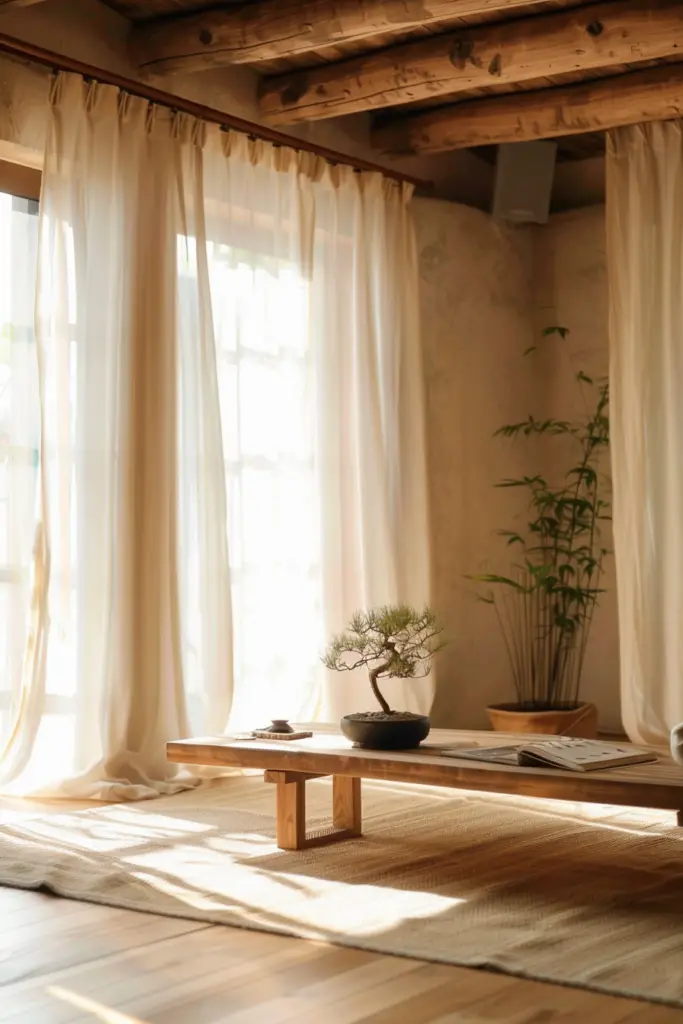
To create a truly inviting Japandi interior, you’ll want to embrace the warmth and natural beauty of wood elements throughout your space. Start by selecting furniture pieces crafted from rich, warm woods like oak or walnut. Their organic textures can bring a sense of calm and balance to your environment. Think about incorporating low-profile wooden tables or minimalist benches that highlight the craftsmanship.
You can also accentuate your design with wooden shelving or decorative beams, which can add structural interest while maintaining simplicity. Consider wooden accessories like bowls or vases to infuse your space with natural charm.
Don’t forget about the flooring; choosing wooden floors can create a seamless flow that ties everything together. By thoughtfully integrating these wooden elements, you’ll foster a serene atmosphere that embodies the essence of Japandi style, merging functionality with organic beauty.
15. Choose Simple Artwork
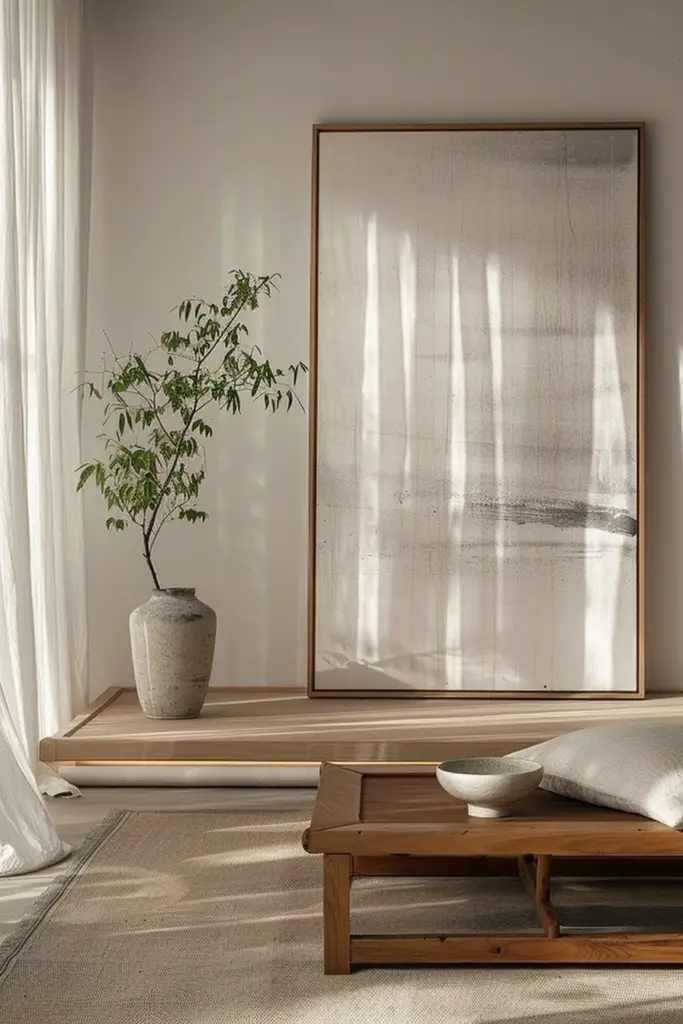
Choosing simple artwork is essential for enhancing the tranquil vibe of a Japandi interior, as it allows the natural beauty of the space to shine without overwhelming it. Opt for pieces that embody minimalism, focusing on calming colors and understated forms. Think about delicate line drawings, abstract shapes, or serene landscapes that evoke a sense of peace.
When selecting artwork, consider natural materials like wood or canvas, which blend harmoniously with the Japandi aesthetic. Choose a few key pieces rather than cluttering walls with numerous items; this creates a focal point that draws the eye without causing distraction.
16. Design With Balance in Mind
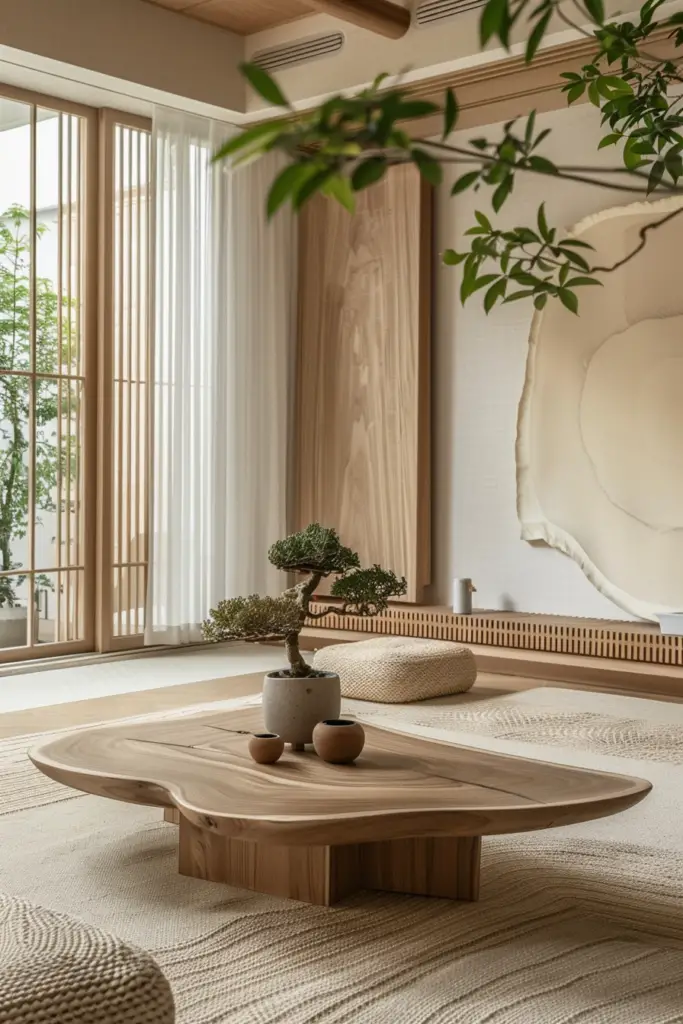
Achieving balance in a Japandi interior is essential, as it creates a harmonious atmosphere that reflects both Japanese and Scandinavian design principles. Start by considering scale and proportion; choose furniture that complements your space without overwhelming it. Incorporate natural materials, like wood and bamboo, which add warmth and texture while maintaining simplicity.
Next, think about color. Opt for a neutral palette, punctuated with earthy tones to evoke tranquility. Mixing light and dark shades can create visual interest while still feeling cohesive.
Don’t forget to focus on functionality. Each piece should serve a purpose, ensuring your space remains uncluttered and serene. Finally, arrange items thoughtfully, allowing negative space to breathe. This balance of positive and negative elements fosters a calming environment, perfect for relaxation and reflection. By embracing these principles, you’ll cultivate a Japandi interior that’s both beautiful and balanced.
17. Use Soft Lighting
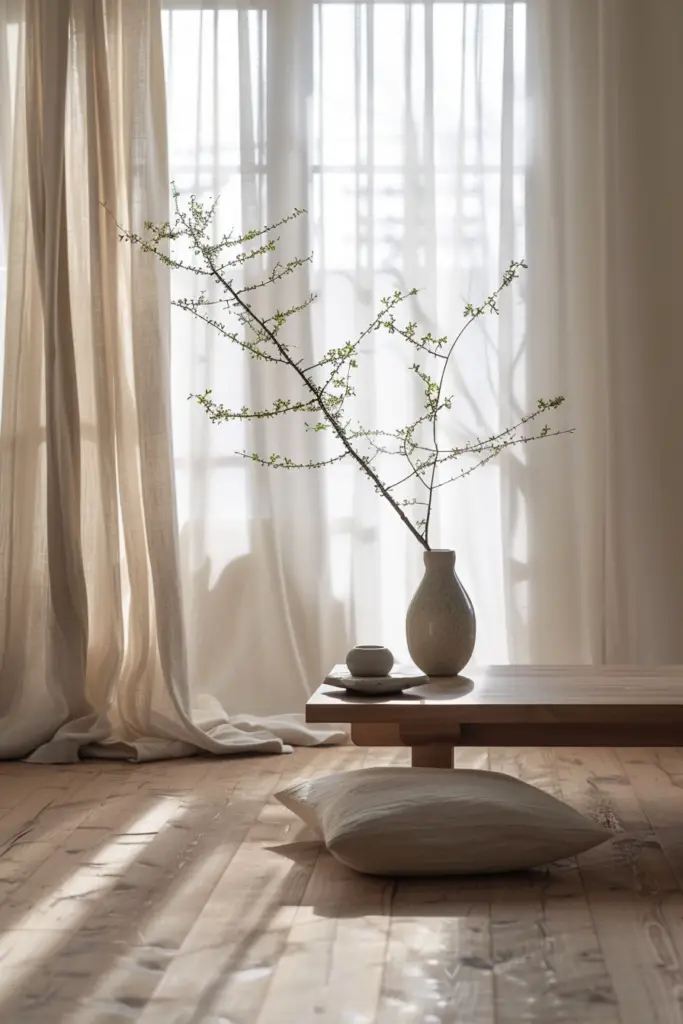
Soft lighting plays an essential role in creating the serene ambiance characteristic of Japandi interiors. It softens the harshness of overhead fixtures and adds warmth to your space, inviting relaxation. Consider using floor lamps with dimmers, or table lamps featuring soft, natural materials like wood or ceramic. These elements not only provide gentle illumination but also complement the minimalist aesthetic.
Incorporating Japanese paper lanterns or Scandinavian-style pendant lights can further enhance the tranquil vibe. The goal is to create a layered lighting scheme that offers both functionality and a calming atmosphere. Avoid overly bright or stark lighting, as this can disrupt the peaceful feel you’re aiming for. Instead, opt for warm, diffuse sources that mimic natural light. By thoughtfully selecting your lighting, you’ll not only elevate the design but also cultivate a soothing environment, perfect for unwinding after a long day.
18. Include Zen Gardens

While you might think of Zen gardens as purely outdoor elements, incorporating them indoors can greatly enhance the tranquility of your Japandi space. These serene landscapes, characterized by gravel, stone, and minimalistic plants, can create a calming focal point in any room.
You could start with a small tabletop Zen garden, where you can rake patterns into the sand, promoting mindfulness and relaxation. For larger spaces, consider a corner dedicated to a miniature Zen garden, featuring smooth stones and perhaps a few carefully placed succulents.
The beauty of these gardens lies in their simplicity, echoing the Japandi philosophy of minimalism. By including a Zen garden, you’re not just adding décor; you’re inviting a sense of peace and balance into your home. This element encourages you to slow down, breathe, and immerse yourself in the tranquil ambiance that defines Japandi living.
19. Add Statement Lighting Fixtures
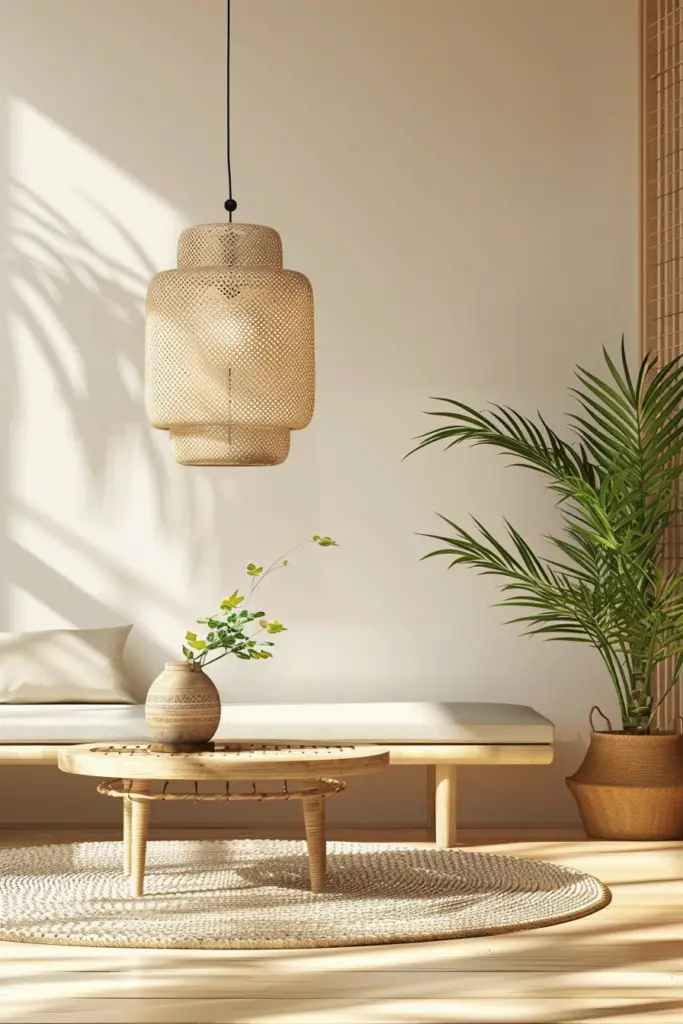
Incorporating a Zen garden can set a serene backdrop for your space, but to truly elevate your Japandi design, consider adding statement lighting fixtures. These elements not only illuminate your room but also serve as artistic focal points that harmonize with your overall aesthetic. Look for fixtures that showcase a blend of natural materials and minimalist forms, like wooden pendant lights or sleek metal sconces.
Consider placing a large, sculptural lamp in a cozy reading nook or a series of hanging lights above your dining area to create an inviting atmosphere. The key is to maintain balance; choose lighting that complements the simplicity of Japandi style without overwhelming the space. Soft, warm light enhances the calming vibe, making your home feel cozy and welcoming. By thoughtfully integrating these fixtures, you’ll enhance the tranquility of your environment while making a striking design statement.
20. Utilize Built-In Storage Solutions

Built-in storage solutions are a game changer for achieving the clean, uncluttered look that defines Japandi style. By incorporating furniture that doubles as storage—like sleek cabinets or minimalist shelves—you can maintain an organized space without sacrificing aesthetics. Think about how built-in solutions can conceal clutter while still showcasing your favorite decor pieces.
You might consider under-window seating with hidden compartments or a wall-mounted unit that seamlessly integrates with your existing design. This not only maximizes space but also enhances the serenity of your home. Opt for natural materials, like wood or bamboo, and stick to neutral tones to keep the tranquil vibe.
21. Create Cozy Nooks
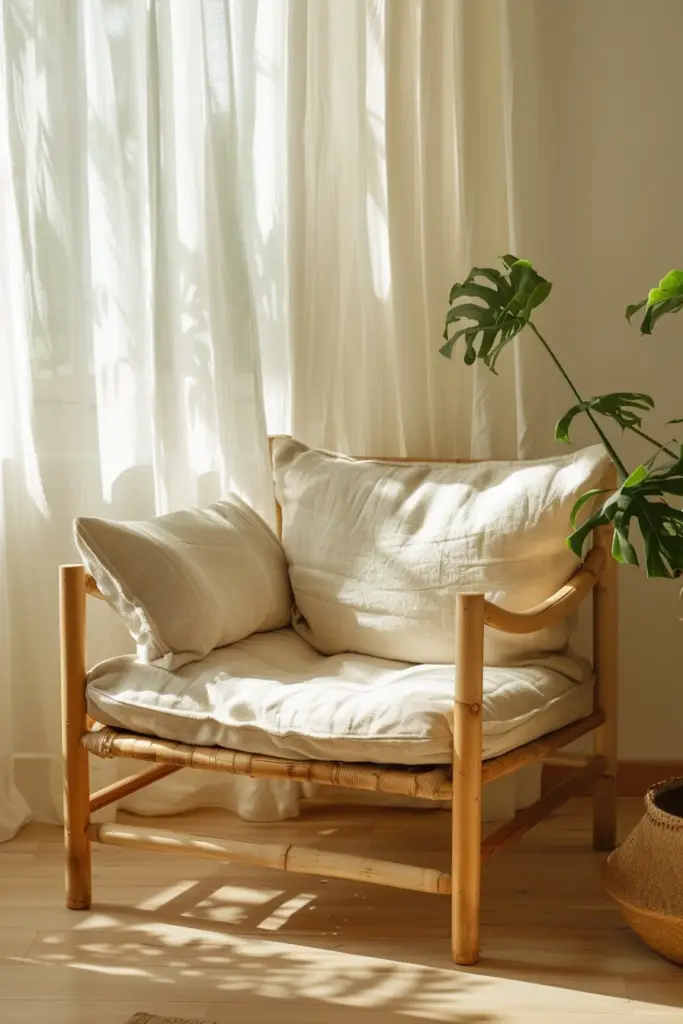
After you’ve optimized your storage, it’s time to focus on creating inviting spaces where you can unwind and recharge. Cozy nooks are essential in Japandi design, blending Scandinavian comfort with Japanese minimalism. Start by choosing a quiet corner, perhaps near a window or beneath a staircase. Layer soft textiles like a plush throw and cushions in natural fabrics, inviting you to sink in and relax.
Incorporate a small side table for your favorite book or a hot cup of tea. Surround yourself with greenery—think potted plants or a simple bonsai—to add a touch of nature. Soft, ambient lighting, such as a stylish floor lamp or candles, enhances the serene atmosphere.
22. Opt for Earthy Tones
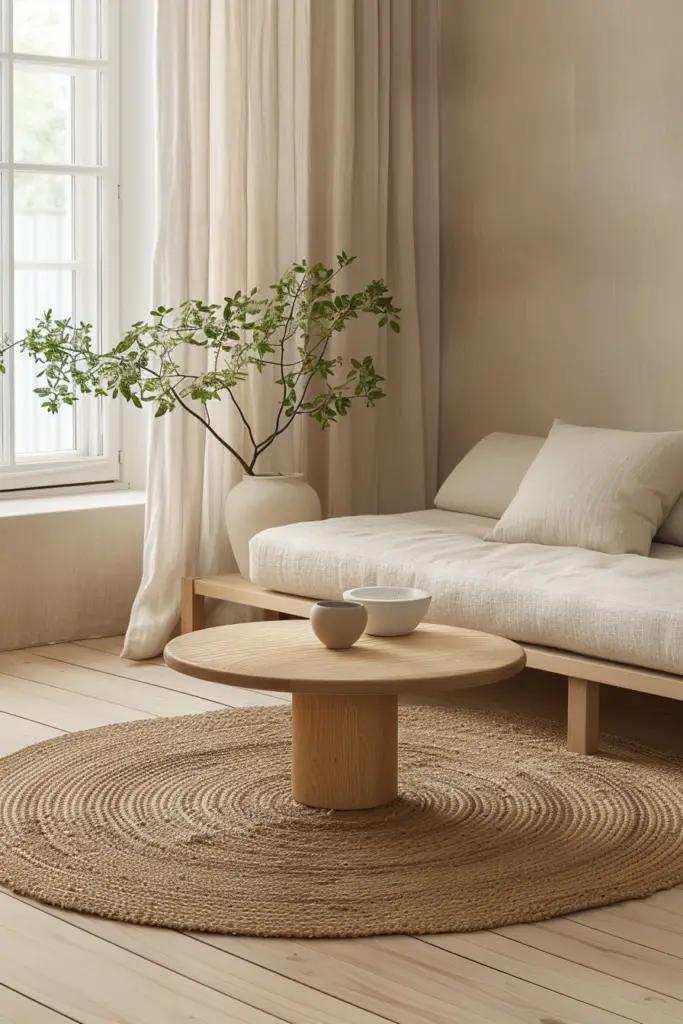
Embracing earthy tones can transform your space into a calming retreat, as these muted colors evoke a sense of nature and tranquility. Think soft browns, warm taupes, and gentle greens that can seamlessly blend with both Japanese and Scandinavian aesthetics. These shades not only create a soothing atmosphere but also foster a connection to the natural world, inviting a sense of peace into your home.
When you choose earthy tones for your walls or furniture, you’re establishing a foundation that promotes balance. Pair these colors with minimalist decor to emphasize simplicity and functionality typical of Japandi style. You can also enhance the look with natural materials like wood and stone, which resonate beautifully with these hues.
Incorporating these tones into your space can help you feel more grounded, making your home a sanctuary where you can unwind and recharge. So, don’t hesitate to explore the calming power of earthy tones!
23. Incorporate Warmth With Rugs
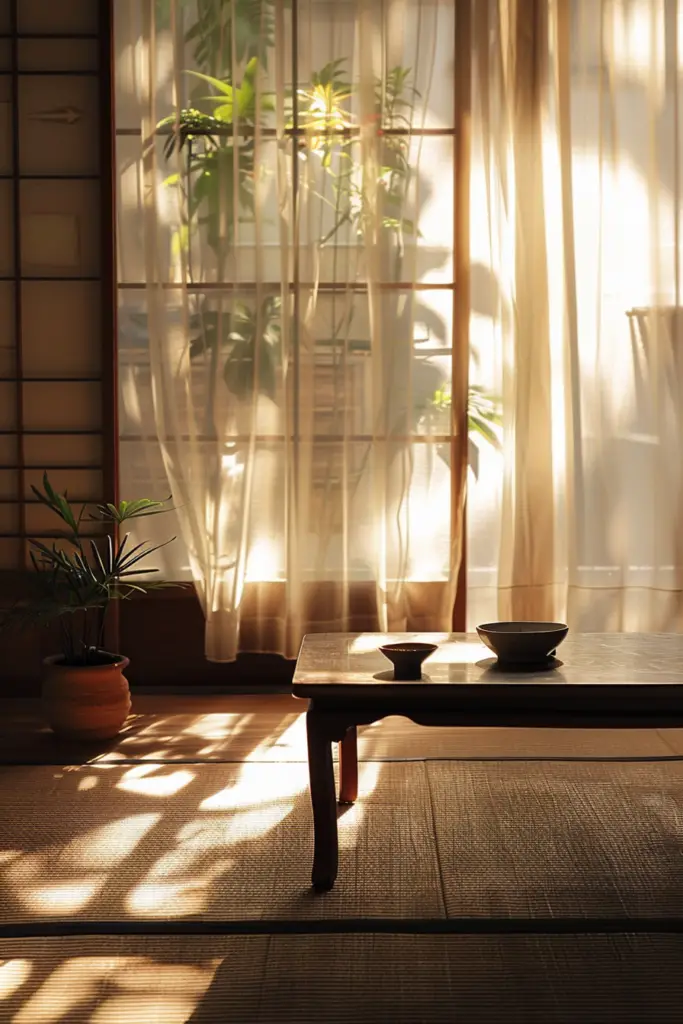
To enhance the cozy and inviting atmosphere created by earthy tones, incorporating warm rugs can add an extra layer of comfort to your Japandi-inspired space. Choose rugs in soft, natural materials like wool or cotton, which not only feel good underfoot but also align with the Japandi ethos of simplicity and functionality. Opt for muted colors like warm beige, terracotta, or soft greys that harmonize with your existing palette.
Layering rugs can also create depth; consider placing a larger, neutral rug underneath a smaller, patterned one for visual interest. Additionally, think about the placement—positioning rugs in key areas like under your coffee table or in reading nooks can define spaces and invite relaxation. Remember, the right rug can not only tie your room together but also soften hard surfaces, making your home feel more welcoming and warm.
24. Feature Minimalist Shelving
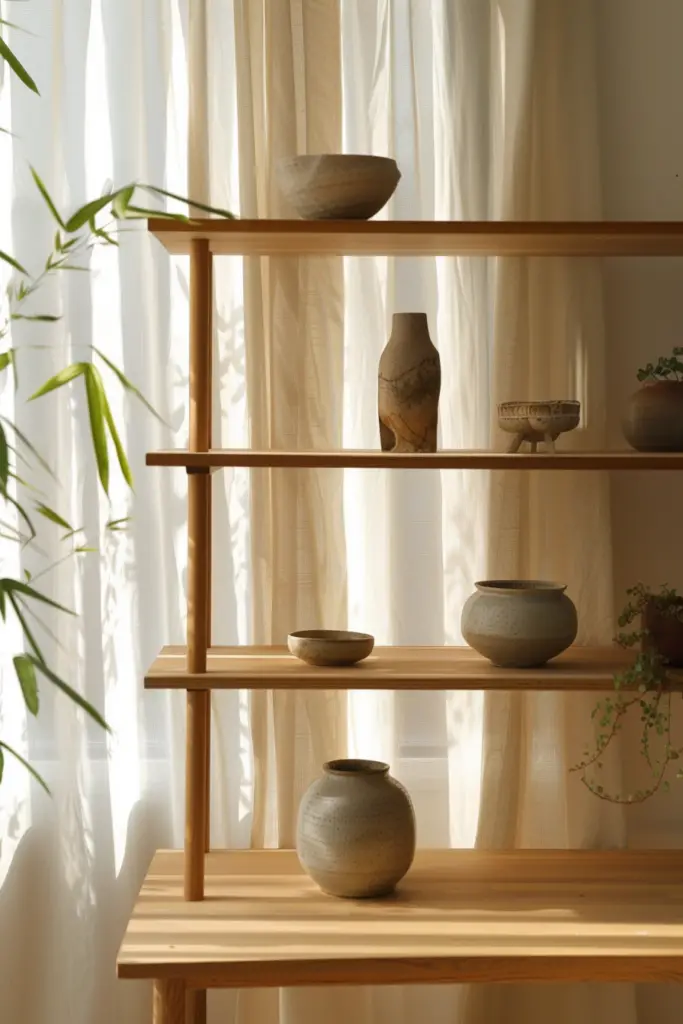
While creating a Japandi-inspired space, featuring minimalist shelving can greatly enhance both functionality and aesthetic appeal. These sleek, unobtrusive shelves not only provide storage but also serve as a canvas for showcasing carefully selected decor. Opt for natural materials like wood or bamboo, which harmonize beautifully with the Japandi ethos of simplicity and warmth.
When arranging your shelves, consider a curated approach. Limit the number of items to maintain a clean look, allowing each piece to breathe. Use neutral colors and organic shapes to create a calming visual flow. Incorporating plants can also add life and a touch of nature, reinforcing that serene atmosphere.
25. Blend Indoor and Outdoor Spaces
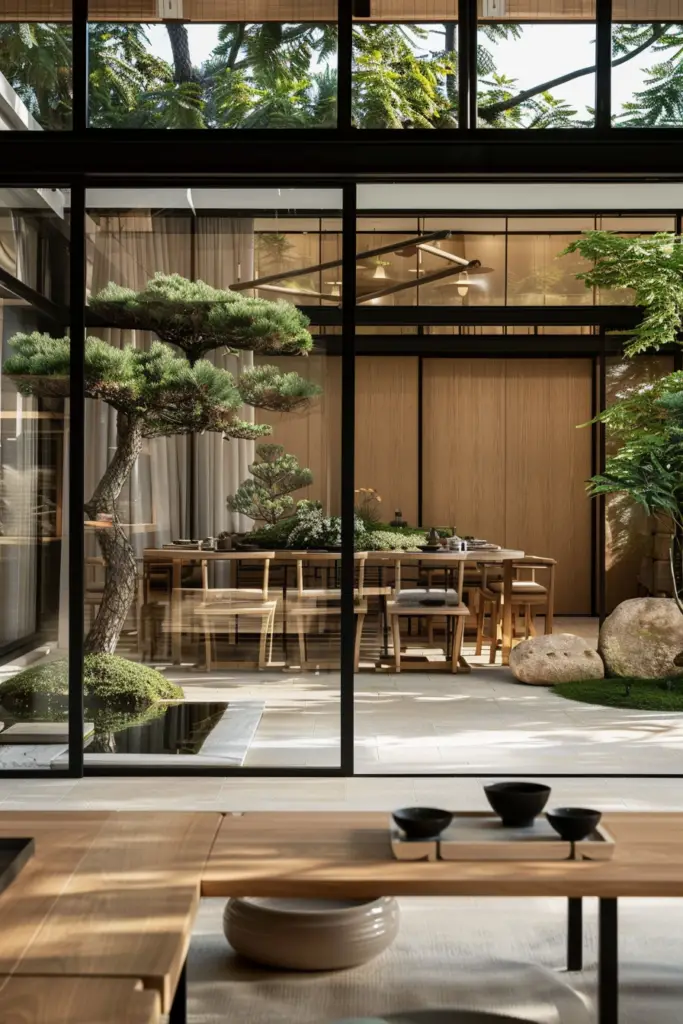
How can you create a seamless shift between indoor and outdoor spaces in your Japandi-inspired home? Start by incorporating large glass doors or expansive windows that invite natural light and views of your outdoor oasis. You’ll want to select materials that harmonize both environments, like a wooden deck that mirrors indoor flooring.
Next, use a neutral color palette to unify the spaces, allowing the tranquility of nature to flow indoors. Consider adding plants or indoor gardens that echo your outdoor landscape, enhancing a sense of continuity.
Lastly, create cozy spots with minimalist outdoor furniture that complements your interior. This setup encourages relaxation and connection with nature, making your home feel more expansive and inviting. By thoughtfully blending these spaces, you’ll cultivate a serene atmosphere that embodies the essence of Japandi design, fostering harmony and balance in your everyday life.
Conclusion
By embracing these 25 Japandi interior ideas, you can effortlessly create a serene space that radiates balance and tranquility. With neutral palettes, natural materials, and minimalist furniture, every corner of your home can invite calmness. Don’t forget the warmth of indoor plants and earthy tones to enhance the atmosphere. By blending indoor and outdoor spaces, you’ll foster a connection with nature, making your home a true sanctuary. Start your journey to a zen-like retreat today!